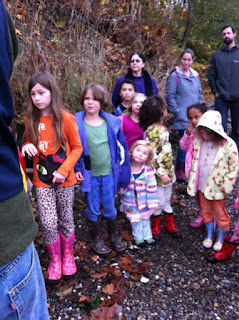Today my class completed our month-long science experiment creating medieval ink from oak galls. We started out with a couple of buckets of oak galls collected by one of our younger friends' parents. This was a pretty involved project, and our science will lead into a really beautiful art project quite soon.
First we squashed the oak galls with enough water that the powder released would stay wet and not airborne. After that, we mixed the galls thoroughly into 5 identical batches.
 |
| They were really lovely before we squashed them. |
 |
| They still look pretty lovely in these jars... |
 |
| Oooh, don't get too close! |
 |
| We kept track of each step of the way. |
 |
| Day 8 we separated the batches and introduced different variables to 4 batches. We kept 1 control batch. |
 |
| Just before separating the batches. |
We separated the batches in this manner: Batch A we kept just the way it was. Batch B had iron added to it. Batch C had iron and vinegar added. Batch D had iron and heat added. Batch E had iron, heat and vinegar added. We created hypotheses about what we thought would happen to the batches, which batch we thought would would turn out the best, and why.
 |
| We let them sit, stirring occasionally, for another week and 1/2. We tested the color of each batch often. |
|
Once our batches had had a chance to react to the different variables (21 days), we began to strain them and tested them one more time. We decided that the batches with heat and chemical change worked the best, but that the batch with heat, chemical AND acid change was the best by far.
 |
| drip, drip, drip... |

 |
| Jen says, "ouch! Don't accidentally dunk your fingers in the hot ink! Oh hey, look, it works really well!" |
Watch this space for images of our Book of Hours, later on. In the meantime...
While we were conducting our science experiment in Theme, we were learning about angles in Math. We used our knowledge of angles to construct and test tetrahedral catapults. What a fun project (educational, too)!
 |
| Okay, so we'll need 25 sticks, and a lot of tape... |
 |
| We'll need a long flinging arm and a source of tension (rubber bands). |
 |
| It's important to measure each stick so the tetrahedron is equilateral. |
 |
| They turned out great! |



































































